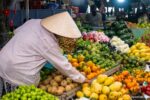Southeast Asia, with its lush landscapes, warm climates, and rich agricultural heritage, is a paradise for tropical fruits. Among these, the pineapple stands out not only for its unique taste but also for its cultural and economic significance. This article explores the fascinating journey of pineapples in Southeast Asia, from their historical roots and cultivation practices to their role in local cuisines and markets.
Historical Roots and Cultural Significance
The story of pineapples in Southeast Asia begins centuries ago, with the fruit believed to have been introduced by European explorers and traders. Pineapples, native to South America, found a new home in the tropical climates of Southeast Asia, where they thrived. Over time, the fruit became deeply embedded in local cultures, symbolizing hospitality, prosperity, and good fortune. In many Southeast Asian countries, pineapples are often used in traditional ceremonies and offerings, reflecting their cultural importance.
Cultivation Practices
The cultivation of pineapples in Southeast Asia varies by region, influenced by climate, soil conditions, and local farming practices. Pineapples are predominantly grown in Thailand, the Philippines, Malaysia, and Indonesia, with each country boasting unique varieties and cultivation techniques. The process begins with the planting of suckers or crowns, followed by meticulous care involving regular watering, fertilization, and pest control. The tropical climate of Southeast Asia, characterized by abundant rainfall and sunshine, provides ideal conditions for pineapple growth. Typically, it takes around 18 to 24 months for a pineapple to mature from planting to harvest.
Pineapple Varieties
Southeast Asia is home to a diverse range of pineapple varieties, each with distinct flavors, textures, and appearances. In Thailand, the ‘Phu Lae’ pineapple is renowned for its small size and sweet, aromatic flesh. The Philippines is famous for the ‘Red Spanish’ pineapple, known for its firm texture and vibrant color, as well as the ‘Queen’ variety, which is prized for its sweetness and juiciness. Malaysia produces the ‘Sarawak’ pineapple, a large, juicy fruit with a golden-yellow flesh, while Indonesia is known for its ‘Smooth Cayenne’ variety, which is widely exported due to its excellent canning properties. These varieties contribute to the rich tapestry of pineapple flavors available in Southeast Asia.
Pineapples in Local Cuisine
Pineapples play a versatile role in Southeast Asian cuisine, adding a burst of flavor and freshness to a wide array of dishes. In Thailand, pineapples are a key ingredient in the famous “Pad Thai” providing a sweet contrast to the savory noodles. The Philippines incorporates pineapples into “Adobo”, a popular dish where the fruit’s sweetness balances the tangy and savory flavors of the meat. In Malaysia, “Pineapple Tarts” are a beloved treat, especially during festive seasons, while in Indonesia, “Rujak” — a spicy fruit salad — often features pineapples for a tangy kick. The fruit is also commonly used in refreshing beverages, desserts, and marinades across the region, showcasing its culinary versatility.
Pineapples in Markets and Exports
Southeast Asia’s bustling markets are a sensory delight, with pineapples taking center stage among the tropical fruits. These markets offer a vibrant display of pineapples, from whole fruits to peeled and sliced pieces ready for immediate consumption. Pineapples are sold fresh, canned, and as dried fruit, catering to both local and international markets. Thailand and the Philippines are among the world’s leading exporters of pineapples, contributing significantly to the global supply. The fruit’s economic importance extends to providing livelihoods for millions of farmers and workers involved in the pineapple industry.
Sustainability and Challenges
The cultivation and export of pineapples in Southeast Asia face several challenges, including environmental sustainability, market fluctuations, and the impact of climate change. Sustainable farming practices are increasingly being adopted to address these challenges, focusing on reducing chemical use, conserving water, and enhancing soil health. Organic pineapple farming is gaining traction, offering a healthier and environmentally friendly alternative. Additionally, efforts are being made to improve supply chain efficiency, ensuring fair prices for farmers and reducing post-harvest losses. Addressing these challenges is crucial for the long-term viability of the pineapple industry in Southeast Asia.
Pineapples are more than just a tropical fruit in Southeast Asia; they are a symbol of the region’s agricultural richness, cultural heritage, and culinary diversity. From the sun-kissed plantations to the bustling markets and kitchens, pineapples play an integral role in the daily lives of millions of people. As you explore Southeast Asia, be sure to savor the sweet and tangy flavors of its pineapples, a true testament to the region’s tropical bounty.





